Armorial of the House of Lusignan
The coats of arms, flags, and badges of the House of Lusignan, royal family in the Levant during the Crusades.
First House of Lusignan
Including attributed arms.
French Nobility
| Blazon | Period | Description |
|---|---|---|
 | 885–1192 | Lords of Lusignan Barry of ten argent and azure Motto: Pour loyauté maintenir "To maintain loyalty" [1] |
.svg.png.webp) | 1192–1393 | Lords of Lusignan, Counts of La Marche, and Angoulême Barry silver and azure eight rooms, a lion gules armed langued and crowned with gold stitching on the whole. |
 | 1221–1250 | Personal Arms of Hugh X[2]
Barry silver and azure, charged with six cubs reds brochants, posed three, two and one. |
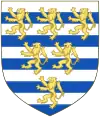 | 1250–1270 | Personal Arms of Hugh XII
Barry silver and azure, charged with six cubs gold brochants, posed three, two and one. |
.svg.png.webp) 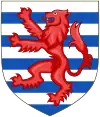 | ?-1274 | Personal Arms of Geoffroy I of Lusignan (Jarnac) (c. 1223/24-b. 1274), lord of Jarnac, Château-Larcher and Châteauneuf
1. Barry silver and azure, charged with a lion rampant-brochant gules, debruised by a four-point label gules (according to his 1246 seal). 2. Barry silver and azure, charged with a lion rampant-brochant gules (according to his 1248 and 1269 seals). |
Cognac
| Blazon | Period | Description |
|---|---|---|
.svg.png.webp) | 12th-13th Century | Lords of Cognac
Barry silver and azure eight parts, the label Gules. |
Lezay
| Blazon | Period | Description |
|---|---|---|
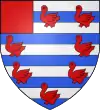 | 12th-13th Century | Lords of Lezay
Barry silver and azure, nine martlets in orle gules surmounted to fair canton gules . |
Vouvant
| Blazon | Period | Description |
|---|---|---|
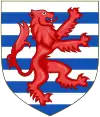 | 12th-13th Century | Geoffroy I and II of Lusignan (Vouvant), lords of Vouvant and Mervent
Barry of ten argent and azure a lion counter-rampant gules. Motto: QVI PLVS MORTIS CONPTEMTOR QVAM LEO FORTIS "Who fears death less than lion's strength."[3] |
Issoudun
| Blazon | Period | Description |
|---|---|---|
.svg.png.webp) | 13th Century | Counts of Eu and Lords of Issoudun
Raoul Ier, first lord of Issoudun and count of Eu, was the younger brother of Hugh IX of Lusignan. Barry of ten argent and azure a label of three points gules |
Rochefoucauld
| Blazon | Period | Description |
|---|---|---|
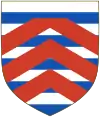 | 10th-12th Century | Lords of Rochefoucauld
Barry of ten argent and azure three chevrons that in chief couped gules |
Parthenay
| Blazon | Period | Description |
|---|---|---|
 | 11th-15th Century | Lords of Parthenay and Retz
Barry of ten argent and azure a bend gules |
Valence
| Blazon | Period | Description |
|---|---|---|
 | 1225–1247 | Guillaume de Lusignan
Personal arms of Guillaume de Lusignan, uterine half brother of King Henry III Barry of ten argent and azure a label of five points gules on each point three lions. Supported with a wyvern on each side.[6] |
.svg.png.webp) | 1247–1324 | Lords of Valencia, Earls of Pembroke and Wexford
Guillaume de Lusignan, known as William de Valence, moved with his brothers and sister to England the request of their half brother King Henry III. Henry made William the Earl of Pembroke. Barry of ten Argent and Azure an orle of martlets Gules |
Hastings
| Blazon | Period | Description |
|---|---|---|
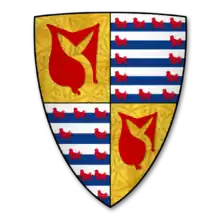 | 1313–1389 | Earls of Pembroke Quarterly, 1 and 4, or, a maunch gules (for Hastings); 2 and 3, barruly argent and azure, an orle of martlets (for Valence) |
Jerusalem Royal Family
| Blazon | Period | Description |
|---|---|---|
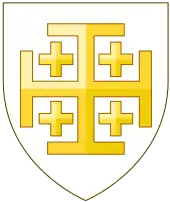 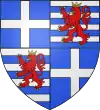 | 1159–1268 | Kings of Jerusalem
Personal arms of Guy de Lusignan, then used as the arms of the Lusignan Kings of Jerusalem after his death until 1268.[7] Quarterly, 1 and 4 in blue with the silver cross and 2 and 3 barry silver and azure eight rooms, a lion rampant, armed, langued and crowned with gold stitching on the whole. |
.svg.png.webp) | 1335–1385 | Prince of Galilee Quarterly, 1 and 4 in silver, a cross of gold, between four crosses of the same and 2 and 3 barry silver and azure eight rooms, a lion gules armed langued and crowned with gold stitching on the whole. |
Royal Family of Jerusalem and Cyprus
| Blazon | Period | Description |
|---|---|---|
.svg.png.webp) | 1194–1268 | Kings of Cyprus
The kingdoms of Jerusalem and Cyrpus split following the death of Guy until they were reunited in 1268 by King Hugh III of Cyprus. Barry silver and azure eight rooms, a lion gules armed langued and crowned with gold stitching on the whole. |
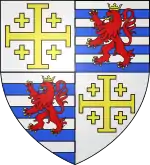 | 1268–1393 | Kings of Cyprus and Jerusalem
Quarterly, 1 and 4 in silver, a cross of gold, between four crosses of the same and 2 and 3 barry silver and azure eight rooms, a lion gules armed langued and crowned with gold stitching on the whole. |
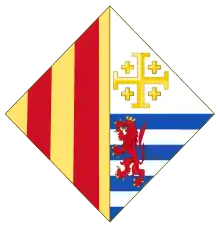 | 1314–1319 | Queen of Aragon |
Second House of Lusignan
Royal Family of Jerusalem, Cyprus, and Armenia
| Blazon | Period | Description |
|---|---|---|
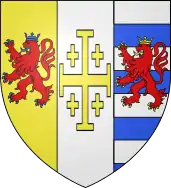 | 1342–1382 | Kings of Armenia Advantage of both, 1 gold lion rampant, armed, langued and crowned azure, 2 silver, a cross of gold, between four crosses of the same and 3 barry money and azure eight rooms, a lion rampant, armed, langued and crowned with gold stitching on the whole. Motto: Pour loyauté maintenir "To maintain loyalty" [8] |
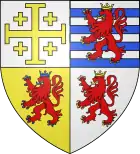 | 1393– | Kings of Armenia, Cyprus, and Jerusalem.
Quartered, 1 in silver, a cross of gold, between four crosses of the same, 2 barry silver and azure eight rooms, a lion rampant, armed, langued and crowned with gold , stitching on the whole, 3 gold lion rampant, armed, langued and crowned azure and 4 silver lion rampant, armed, langued and crowned with gold. Motto: Pour loyauté maintenir "To maintain loyalty" |
Flags
| Flag | Period | Description |
|---|---|---|
 | 12th-14th Centuries | Flag of Lusignan Kings of Cyprus[9][10]
Flag from Kyrenia Castle. The fleur-de-lis symbolised the Lusignan's French ancestry and the cross symbolized Jerusalem and the Holy Sepulchre. |
| Flag | Period | Description |
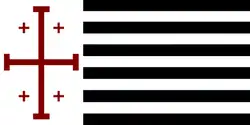 | 14th Century | Flag of Lusignan Kings of Armenia |
Symbols
Roses, lions, dragons and mermaids were Lusignan symbols and heraldic elements.[11]
References
- "Son Altesse royale Marie de Lusignan, princesse de Chypre, de Jérusalem et d'Arménie. Notes biographiques". 1888.
- Seal of Hugues X de Lusignan dated 1224. Sceau équestre: le comte à cheval, en costume de chasse, le cor au cou et tenant à la main un petit chien posé sur la croupe du cheval. Legend: * SIGILL’ : HVGONIS : DE : LEZINIACO : COMITIS : ENGOLISME; Revers. Écu burelé. Le champ à arabesques. Legend: + SIGILL’ " HVGONIS : DE : LEZINIACO : COMITIS : MARCHIE.). Douet d’Arcq, Collection de Sceaux des Archives de l’Empire 1, 1 (1863), 397–398.
- http://jm.ouvrard.pagesperso-orange.fr/armor/fami/l/lusign.htm
- http://jm.ouvrard.pagesperso-orange.fr/armor/fami/l/la%20rochefoucauld.htm
-
- Courcy, Pol Poitier de (1862). In Nobiliaire et armorial de Bretagne, Volume 2. Forest, Grimaud, Aubry. p. 346. Google Book Search. Retrieved on November 12, 2014.
-
- Richardson, Douglas (2011). Kimball G. Everingham. In Plantagenet Ancestry: A Study In Colonial And Medieval Families, 2nd Edition. CreateSpace. p. 679. ISBN 1449966314. Google Book Search. Retrieved on November 12, 2014.
- http://jm.ouvrard.pagesperso-orange.fr/armor/fami/l/lusign.htm
- Latrie, Louis Mas (1852). "Histoire de l'île de Chypre sous le règne des princes de la maison de Lusignan".
- Piperno, Roberto. "Caterina's Bequest - Cirenes (Kyrenia)." Caterina's Bequest - Cirenes (Kyrenia). N.p., n.d. Web. 26 Nov. 2014.
- Fuller, Michael, PhD, and Neathery Fuller. "Kyrena." Turkish Cyprus. St. Louis Community College, Mar. 2004. Web. 26 Nov. 2014.
- Coureas, Nicholas, P. W. Edbury, and Michael J. K. Walsh. Medieval and Renaissance Famagusta: Studies in Architecture, Art and History. p. 94. N.p.: n.p., n.d. Web.